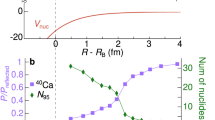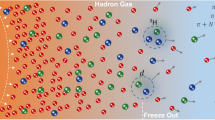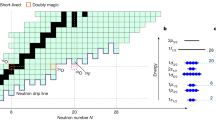Abstract
Unstable heavy atomic nuclei not found in nature can be created by fusing two stable nuclei, in a process analogous to colliding charged droplets of liquid. Recently, the formation of a handful of super-heavy nuclei with atomic numbers 114 (ref. 1) and 116 (ref. 2) has been achieved by fusion of heavy nuclei. The electrostatic energy of such systems is very large (which is the reason super-heavy nuclei are unstable), so although the two nuclei may initially be captured by the nuclear potential, rather than fusing, they almost always separate after transfer of mass to the lighter nucleus. This process, called quasi-fission3,4, can inhibit fusion by many orders of magnitude. Understanding this inhibition may hold the key to forming more super-heavy elements. Theoretically, inhibition is predicted (ref. 5 and references therein) when the product Z1Z2 of the charges of the projectile and target nuclei is larger than about 1,600. Here we report measurements of three fusion reactions with Z1Z2 around half this value, each forming 216 88Ra. We find convincing model-independent evidence both of inhibition of fusion, and of the presence of quasi-fission. These results defy interpretation within the standard picture of nuclear fusion and fission.
This is a preview of subscription content, access via your institution
Access options
Subscribe to this journal
Receive 51 print issues and online access
$199.00 per year
only $3.90 per issue
Buy this article
- Purchase on Springer Link
- Instant access to full article PDF
Prices may be subject to local taxes which are calculated during checkout




Similar content being viewed by others
References
Oganessian, Yu. Ts. et al. Synthesis of nuclei of the superheavy element 114 in reactions induced by 48Ca. Nature 400, 242–245 (1999).
Oganessian, Yu. Ts. et al. Observation of the decay of 292116. Phys. Rev. C 63, 011301R-1–011301R-2 (2001).
Back, B. B. Complete fusion and quasifission in reactions between heavy ions. Phys. Rev. C 31, 2104–2112 (1985).
Toke, J. et al. Quasi-fission—the mass-drift mode in heavy-ion reactions. Nucl. Phys. A 440, 327–365 (1985).
Blocki, J. P., Feldmeier, H. & Swiatecki, W. J. Dynamical hindrance to compound-nucleus formation in heavy-ion reactions. Nucl. Phys. A 459, 145–172 (1986).
Hinde, D. J., Leigh, J. R., Newton, J. O., Galster, W. & Sie, S. Fission and evaporation competition in 200Pb. Nucl. Phys. A 385, 109–132 (1982).
Hahn, R. L., Toth, K. S., LeBeyec, Y., Lagarde, B. & Guidry, M. W. Reactions with 40Ar and 84Kr leading to the same compound nucleus, 200Po. Phys. Rev. C 36, 2132–2135 (1987).
Sahm, C.-C. et al. Fusion probability of symmetric heavy, nuclear systems determined from evaporation-residue cross sections. Nucl. Phys. A 441, 316–343 (1985).
Morton, C. R. et al. Resolution of anomalous fission fragment anisotropies for the 16O + 208Pb reaction. Phys. Rev. C 52, 243–251 (1995).
Hinde, D. J. et al. Conclusive evidence for the influence of nuclear orientation on quasifission. Phys. Rev. C 53, 1290–1300 (1996).
Bohr, N. Neutron capture and nuclear constitution. Nature 137, 344–348 (1936).
Dasgupta, M., Hinde, D. J., Rowley, N. & Stefanini, A. M. Measuring barriers to fusion. Annu. Rev. Nucl. Part. Sci. 48, 401–462 (1998).
Hagino, K., Rowley, N. & Kruppa, A. T. A program for coupled-channels calculations with all order couplings for heavy-ion fusion reactions. Comput. Phys. Commun. 123, 143–150 (1999).
Lestone, J. P. et al. Pre-scission charged-particle multiplicities following the reactions 164,167,170Er + 28Si. Nucl. Phys. A 559, 277–316 (1993).
Vergani, P. et al. Complete and incomplete fusion and emission of preequilibrium nucleons in the interaction of 12C with 197Au below 10 MeV/nucleon. Phys. Rev. C 48, 1815–1827 (1993).
Rowley, N., Leigh, J. R., Wei, J. X. & Lindsay, R. Obtaining average angular momenta from fusion excitation functions near the Coulomb barrier. Phys. Lett. B 314, 179–184 (1993).
Balantekin, A. B., DeWeerd, A. J. & Kuyucak, S. Relations between fusion cross sections and average angular momenta. Phys. Rev. C 54, 1853–1862 (1996).
Ramamurthy, V. S. et al. Entrance-channel dependence of fission-fragment anisotropies: a direct experimental signature of fission before equilibration. Phys. Rev. Lett. 65, 25–28 (1990).
Ravi Prasad, G. V. & Ramamurthy, V. S. Light fragment emission during mass asymmetry relaxation in heavy-ion induced fission. Phys. Rev. C 54, 815–821 (1996).
Davies, K. T. R. & Sierk, A. J. Conditional saddle-point configurations. Phys. Rev. C 31, 915–922 (1985).
Möller, P. & Nix, J. R. Potential-energy surfaces for asymmetric heavy-ion reactions. Nucl. Phys. A 281, 354–372 (1977).
Abe, Y., Ayik, S., Reinhard, P.-G. & Suraud, E. On stochastic approaches of nuclear dynamics. Phys. Rep. 275, 49–196 (1996).
Acknowledgements
M.D. acknowledges the support of a QEII Fellowship.
Author information
Authors and Affiliations
Corresponding author
Rights and permissions
About this article
Cite this article
Berriman, A., Hinde, D., Dasgupta, M. et al. Unexpected inhibition of fusion in nucleus–nucleus collisions. Nature 413, 144–147 (2001). https://doi.org/10.1038/35093069
Received:
Accepted:
Issue Date:
DOI: https://doi.org/10.1038/35093069
This article is cited by
-
Fragmentation analysis of various compound nuclei formed in the mass region 200 and the associated entrance channel effects
Pramana (2023)
-
Understanding fission fragment mass distributions in a shape-modified random neck rupture model
Pramana (2022)
-
Systematics of multinucleon transfer in heavy-ion reactions
Pramana (2020)
-
Fission fragment mass and angular distributions: Probes to study non-equilibrium fission
Pramana (2015)
-
Non-compound nucleus fission in actinide and pre-actinide regions
Pramana (2015)
Comments
By submitting a comment you agree to abide by our Terms and Community Guidelines. If you find something abusive or that does not comply with our terms or guidelines please flag it as inappropriate.



